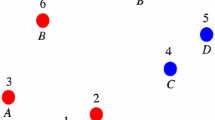Abstract
It is shown that the numberc n of self-avoiding walks of lengthn in ℤd is an increasing function ofn.
Similar content being viewed by others
References
J. M. Hammersley and D. J. A. Welsh, Further results on the rate of convergence to the connective constant of the hypercubical lattice,Q. J. Math. Ser. 2 13:108–110 (1962).
H. Kesten, On the number of self-avoiding walks,J. Math. Phys. 4:960–969 (1963).
N. Madras and A. D. Sokal, The pivot algorithm: A highly efficient Monte Carlo method for self-avoiding walks,J. Stat. Phys. 50:109–186 (1988).
G. Slade, The diffusion of self-avoiding random walk in high dimensions,Commun. Math. Phys. 110:661–683 (1987).
S. G. Whittington, Statistical mechanics of polymer solutions and polymer absorption, inAdvances in Chemical Physics, Vol. 51 (Wiley, New York, 1982), pp. 1–48.
Author information
Authors and Affiliations
Rights and permissions
About this article
Cite this article
O'Brien, G.L. Monotonicity of the number of self-avoiding walks. J Stat Phys 59, 969–979 (1990). https://doi.org/10.1007/BF01025858
Received:
Revised:
Issue Date:
DOI: https://doi.org/10.1007/BF01025858




